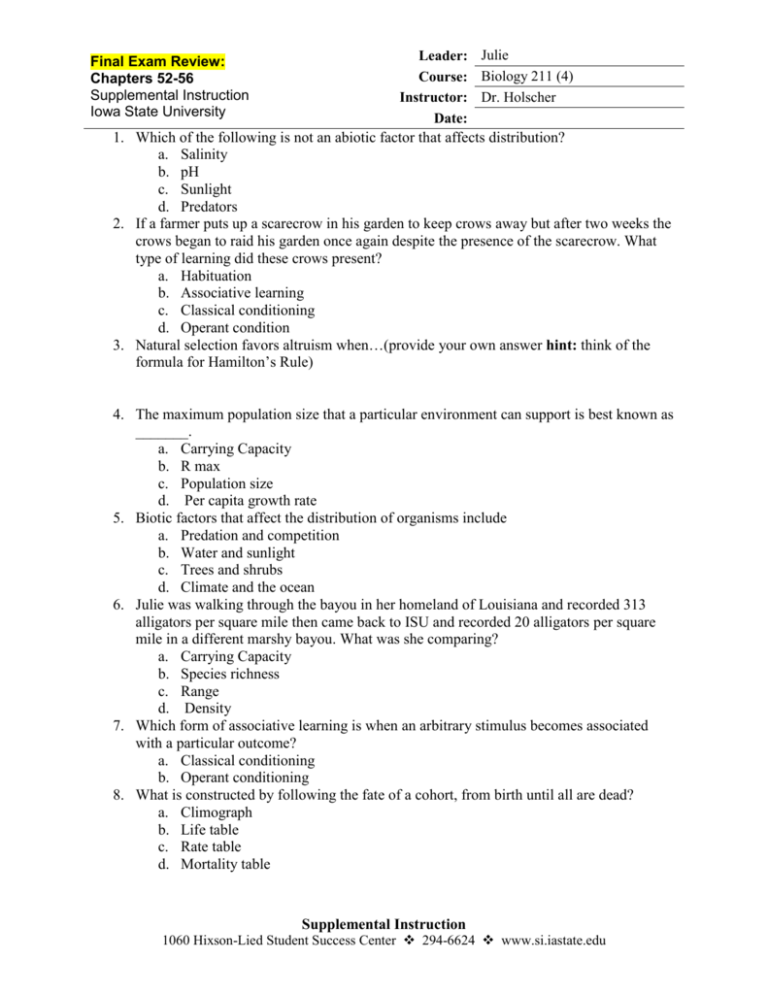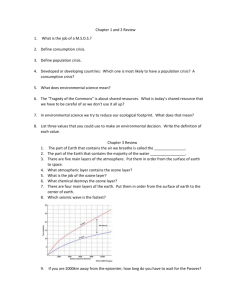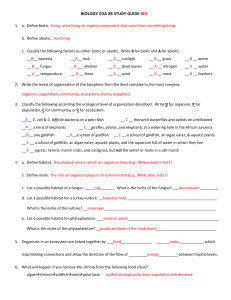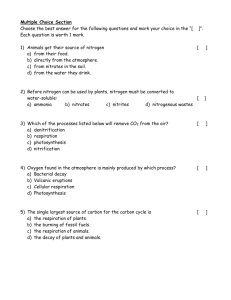Final Exam Review - Iowa State University
advertisement

Leader: Julie Course: Biology 211 (4) Instructor: Dr. Holscher Date: 1. Which of the following is not an abiotic factor that affects distribution? a. Salinity b. pH c. Sunlight d. Predators 2. If a farmer puts up a scarecrow in his garden to keep crows away but after two weeks the crows began to raid his garden once again despite the presence of the scarecrow. What type of learning did these crows present? a. Habituation b. Associative learning c. Classical conditioning d. Operant condition 3. Natural selection favors altruism when…(provide your own answer hint: think of the formula for Hamilton’s Rule) Final Exam Review: Chapters 52-56 Supplemental Instruction Iowa State University 4. The maximum population size that a particular environment can support is best known as _______. a. Carrying Capacity b. R max c. Population size d. Per capita growth rate 5. Biotic factors that affect the distribution of organisms include a. Predation and competition b. Water and sunlight c. Trees and shrubs d. Climate and the ocean 6. Julie was walking through the bayou in her homeland of Louisiana and recorded 313 alligators per square mile then came back to ISU and recorded 20 alligators per square mile in a different marshy bayou. What was she comparing? a. Carrying Capacity b. Species richness c. Range d. Density 7. Which form of associative learning is when an arbitrary stimulus becomes associated with a particular outcome? a. Classical conditioning b. Operant conditioning 8. What is constructed by following the fate of a cohort, from birth until all are dead? a. Climograph b. Life table c. Rate table d. Mortality table Supplemental Instruction 1060 Hixson-Lied Student Success Center 294-6624 www.si.iastate.edu 9. The gradual and continuous change in species composition and community structure over time is known as ______. a. Remodeling b. Succession c. Commensalism d. Relative Abundance 10. Interactions among organisms are referred to as _______. a. Organismal interaction b. Biotic interaction c. Community interaction d. Abiotic interaction 11. List the 3 different types of dispersion and identify the most and least common type. (provide your own answers) 12. A graph that charts the annual precipitation on the y axis and average temperature on the x axis is called a _____________. a. Food web b. Biome map c. Climograph d. Biograph 13. When a dog is the first thing a new born goose sees, it believes that dog is its parent. This critical period learning is known as which of the following? a. Habituation b. Imprinting c. Classical Conditioning d. Operant Conditioning 14. Exponential population growth results in what type of curve? a. S-shaped b. J-shaped c. M-shaped d. U-shaped 15. In a life table of survivorship, humans would most likely be a. Type 1 b. Type 2 c. Type 3 16. Trophic level transfer efficiency is the amount of energy at one tropic level that is acquired by the trophic level above and incorporated into biomass. This usually averages ______. a. 10% each trophic level b. 20% each trophic level c. 40% each trophic level d. 50% each trophic level 17. The study of how births and deaths change a population size over time is called a. density b. dispersion c. demography d. distance 18. Which properly describes the difference between taxis and kinesis in animal movement? a. Taxis is a long range seasonal movement and kinesis is an oriented movement towards or away from a stimulus b. Taxis is a simple change in activity in response to a stimulus and kinesis is an oriented movement towards or away from a stimulus c. Taxis is an oriented movement towards or away from a stimulus and kinesis is a long range seasonal movement d. Taxis is an oriented movement towards or away from a stimulus and kinesis is a simple change in activity in response to stimulus(random movement) 19. What is the coefficient relatedness between relatives? (probability that two individuals will share a copy of a particular gene) a. .05 b. .25 c. .5 d. .75 20. Which biome is the largest biome found on earth? a. Tundra b. Open Ocean c. Desert d. Tropical Rain Forest 21. What two physical properties of an island will increase species richness? (provide own answer) 22. Describe Gross primary production (GPP) and Net primary production (NPP) . (provide own answers) 23. Which aquatic zone describes the area where light does not reach? a. Photic zone b. Benthic zone c. Aphotic zone d. Littoral zone 24. Permafrost that restricts plant growth is a characteristic of which biome? a. Cold dessert b. Temperate grassland c. Tundra d. Taiga 25. Chemical communication between organisms of the same species is accomplished by which of the following? a. Auditory communication b. Tactile communication c. Pheromone d. Visual Communication 26. Which of the following leads to an addition of density? a. Birth and Emigration b. Birth and Immigration c. Death and Immigration d. Death and Emigration 27. A poisonous frog that is brightly colored displays what type of coloration? a. Aposematic b. Cryptic c. Mullerian d. Batesian 28. Most food webs studied to date have chains consisting of _____ links maximum. a. 5 b. 6 c. 7 d. 8 29. Which is the most important abiotic factor affecting distribution? a. Water b. Salinity c. Temperature d. Sunlight 30. You are observing a population of deer when you notice that the number of adult deer has decreased and is lower than previously observed. One explanation for such an observation would be a. Increased emigration b. Decreased emigration c. Increased immigration d. Decreased immigration 31. Which best describes what happens to chemical energy that is not converted to new biomass in the process of energy transfer between tropic levels in an ecosystem? a. It recycles through the environment like energy does b. It is lost as heat according to the 1st law of thermodynamics c. It is lost as heat according to the 2nd law of thermodynamics d. What is thermodynamics? 32. What allows there to be seasons on earth? a. Coriolis effect b. Solar intensity c. Tilt of the earth’s axis d. Microclimate e. Hadley cells 33. Species richness increases when… (provide own answer) 34. A cohort is a life table is a group of individuals of the same ________. a. Gender b. Age c. Dispersion pattern d. Community 35. Species richness increases a. As community size decreases b. As rates of precipitation decrease c. As you travel north from the equator d. As you travel north from the south pole 36. Which of the following is an example of cryptic coloration? a. Chloroplasts in a leaf reflects green light which makes the leaf look green b. A salamander that has grey and dark speckled skin to look like sand c. A poisonous frog that displays bright color 37. ________ mimicry is when two or more harmful species resemble each other while ________ mimicry is when a harmless species mimics a harmful species. a. Batesian, Mullerian b. Mullerian, Batesian 38. Regardless of an ecosystem’s size energy flows through an ecosystem while matter (chemicals) cycle within an ecosystem. a. True b. False 39. Which biome has substantial rainfall yet a distinct dry season and a dense forest floor? a. Tropical deciduous forest b. Temperate rainforest c. Temperate deciduous forest d. Tropical grassland 40. Which is the proper order of the tropic levels? a. Primary producer, secondary consumer, primary consumer, tertiary consumer b. Primary consumer, secondary consumer, tertiary consumer, primary producer c. Primary producer, primary consumer, secondary consumer, , tertiary consumer d. Primary consumer, tertiary consumer, secondary consumer, , primary producer 41. 5,000 kcal of producer could support approximately _____ kcal of a secondary consumer? a. 10,000 kcal b. 5,000 kcal c. 500 kcal d. 50 kcal 42. T/F: Intraspecific competition occurs between individuals of the same species and interspecific competition occurs between individuals of different species? a. T b. F 43. Commensalism is an interaction when… a. Both species benefit b. One species benefits and the other suffers c. One species benefits and the other has no affect 44. Zero population growth occurs when _______ ______ equals _______ ______. (provide own answer) 45. Demography is the study of which of the following? a. Reproductive strategies b. Change in population size over time c. Pattern of spacing among individuals d. Number of individuals in an area 46. Some animals tend to risk their lives for the sake of the fitness of the group. This behavior is called a. Polygyny b. Polyandry c. Optimal foraging d. Reciprocal altruism 47. A fixed action potential refers to which of the following a. Behavior that is developmentally fixed in all individuals in a population b. A sequence of unlearned acts that is unchangeable c. An action that benefits others at a cost to oneself d. Study of birth rates and death rates within a population 48. The rate at which producers convert solar energy to chemical energy, minus the energy used during respiration, is called a. Trophic efficiency b. Secondary production c. Net primary production d. Biological magnification 49. A biome is a major type of __________. (provide own answer) 50. Resource partitioning would be most likely to occur between a. Sympatric populations of a predator and its prey b. Allopatric populations of the same animal species c. Allopatric populations of species with similar ecological niches d. Sympatric populations with similar ecological niches 51. If you have any other questions about anything from the notes or the study guide you can stay ask your SI leader Julie. Otherwise you’re free to leave. It has been a joy to be your SI leader and I thank you for your attendance. Good luck on your final and best of the luck in the future!










